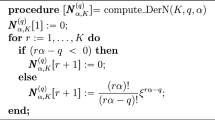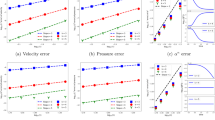Abstract
We present a computational framework for dimension reduction and surrogate modeling to accelerate uncertainty quantification in computationally intensive models with high-dimensional inputs and function-valued outputs. Our driving application is multiphase flow in saturated-unsaturated porous media in the context of radioactive waste storage. For fast input dimension reduction, we utilize an approximate global sensitivity measure, for function-valued outputs, motivated by ideas from the active subspace methods. The proposed approach does not require expensive gradient computations. We generate an efficient surrogate model by combining a truncated Karhunen-Loéve (KL) expansion of the output with polynomial chaos expansions, for the output KL modes, constructed in the reduced parameter space. We demonstrate the effectiveness of the proposed surrogate modeling approach with a comprehensive set of numerical experiments, where we consider a number of function-valued (temporally or spatially distributed) QoIs.
Similar content being viewed by others
Data Availability
Data sharing is not applicable to this article as no datasets were generated or analysed during the current study. The results reported in this article are all based on numerical simulations. The details of the benchmark problem considered can be found in [8].
References
Alexanderian, A., Gremaud, P., Smith, R.: Variance-based sensitivity analysis for time-dependent processes. Reliability Engineering & System Safety (2020)
Alexanderian, A., Reese, W., Smith, R. C, Yu, M.: Model input and output dimension reduction using Karhunen–Loève expansions with application to biotransport. ASCE-ASME J Risk and Uncert in Engrg Sys Part B Mech Engrg, 5(4) (2019)
Alexanderian, A., Winokur, J., Sraj, I., Srinivasan, A., Iskandarani, M., Thacker, W. C, Knio, O. M: Global sensitivity analysis in an ocean general circulation model: a sparse spectral projection approach. Comput. Geosci. 16(3), 757–778 (2012)
Angelini, O., Chavant, C., Chénier, E., Eymard, R., Granet, S.: Finite volume approximation of a diffusion-dissolution model and application to nuclear waste storage. Math. Comput. Simul. 81(10), 2001–2017 (2011)
Saad, M., Dia, B. M., Saad, B.: Modeling and simulation of partially miscible two-phase flow with kinetics mass transfer. Mathematics and Computers in Simulation (2020)
Betz, W., Papaioannou, I., Straub, D.: Numerical methods for the discretization of random fields by means of the Karhunen–Loève expansion. Comput. Methods Appl. Mech. Eng. 271, 109–129 (2014)
Blatman, G., Sudret, B.: Efficient computation of global sensitivity indices using sparse polynomial chaos expansions. Reliab. Eng. Syst. Safety 95(11), 1216–1229 (2010)
Bourgeat, A., Granet, S., Smaï, F.: Compositional two-phase flow in saturated-unsaturated porous media: benchmarks for phase appearance/disappearance. Radon Series on Computational and Applied Mathematics: Simulation of Flow in Porous Media (2012)
Bourgeat, A., Jurak, M., Smaï, F.: Two-phase, partially miscible flow and transport modeling in porous media; application to gaz migration in a nuclear waste repository. Comput. Geosci. 6, 309–325 (2009)
Christie, M., Demyanov, V., Erbas, D.: Uncertainty quantification for porous media flows. J. Comput. Phys. 217(1), 143–158 (2006)
Cleaves, H. L., Alexanderian, A., Guy, H., Smith, R. C., Yu, M.: Derivative-based global sensitivity analysis for models with high-dimension al inputs and functional outputs. SIAM J. Sci. Comput. 41, A3524–A3551 (2019)
Constantine, P.: Active Subspaces: Emerging ideas for dimension reduction in parameter studies. Society for Industrial and Applied Mathematics (2015)
Constantine, P., Diaz, P.: Global sensitivity metrics from active subspaces. Reliab. Eng. Syst. Saf. 162, 1–13 (2017)
Costa, A.: Permeability-porosity relationship: A reexamination of the Kozeny-Carman equation based on a fractal pore-space geometry assumption. Geophysical research letters, 33(2) (2006)
Crestaux, T., Le Maıtre, O., Martinez, J.-M.: Polynomial chaos expansion for sensitivity analysis. Reliab. Eng. Syst. Safety 94(7), 1161–1172 (2009)
Fajraoui, N., Marelli, S., Sudret, B.: Sequential design of experiment for sparse polynomial chaos expansions. SIAM/ASA Journal on Uncertainty Quantification 5(1), 1061–1085 (2017)
Gamboa, F., Janon, A., Klein, T., Lagnoux, A.: Sensitivity analysis for multidimensional and functional outputs. Electron. J. Statist. 8(1), 575–603 (2014)
Grey, Z. J, Constantine, P. G: Active subspaces of airfoil shape parameterizations. AIAA J. 56(5), 2003–2017 (2018)
Guy, H., Alexanderian, A., Yu, M.: A distributed active subspace method for scalable surrogate modeling of function valued outputs. arXiv:1908.02694 (2019)
Hart, JL, Gremaud, PA, David, T: Global sensitivity analysis of high-dimensional neuroscience models An example of neurovascular coupling. Bull. Math. Sci. 81(6), 1805–1828 (2019)
Helton, J.C.: Uncertainty and sensitivity analysis techniques for use in performance assessment for radioactive waste disposal. Reliab. Eng. Syst. Safety 42(2-3), 327–367 (1993)
Kress, R.: Linear Integral Equations, 3rd edn. Springer, New York (2014)
Kucherenko, S, Rodriguez-Fernandez, M., Pantelides, C, Shah, N.: Monte Carlo evaluation of derivative-based global sensitivity measures. Reliab. Eng. Syst. Safety 94(7), 1135–1148 (2009)
Kucherenko, S., Iooss, B.: Derivative-based global sensitivity measures. In: Ghanem, R., Higdon, D., Owhadi, H. (eds.) Handbook of Uncertainty Quantification. Springer (2017)
Le Maître, O., Knio, O.: Spectral methods for uncertainty quantification: with applications to computational fluid dynamics. Springer, Berlin (2010)
Li, G., Iskandarani, M., Le Hénaff, M., Winokur, J., Maître Le, O.P., Knio, O. M: Quantifying initial and wind forcing uncertainties in the gulf of Mexico. Comput. Geosci. 20(5), 1133–1153 (2016)
Lie, K.-A.: An introduction to reservoir simulation using MATLAB/GNU Octave: User guide for the MATLAB Reservoir Simulation Toolbox (MRST). Cambridge University Press, Cambridge (2019)
Loève, M.: Probability theory. I, 4th edn., vol. 45. Springer, New York-Heidelberg (1977). Graduate Texts in Mathematics
Najm, H.N.: Uncertainty quantification and polynomial chaos techniques in computational fluid dynamics. Annu. Rev. Fluid Mech. 41, 35–52 (2009)
Namhata, A., Oladyshkin, S., Dilmore, R. M, Zhang, L., Nakles, D. V: Probabilistic assessment of above zone pressure predictions at a geologic carbon storage site. Scientific Reports 6(1), 1–12 (2016)
Neumann, R., Bastian, P., Ippisch, O.: Modeling and simulation of two-phase two-component flow with disappearing nonwetting phase. Comput. Geosci. 17(1), 139–149 (2012)
Saad, B. M, Alexanderian, A., Prudhomme, S., Knio, O. M: Probabilistic modeling and global sensitivity analysis for co2 storage in geological formations: a spectral approach. Appl. Math. Model. 53, 584–601 (2018)
Seshadri, P., Shahpar, S., Constantine, P., Parks, G., Adams, M.: Turbomachinery active subspace performance maps. Journal of Turbomachinery, 140(4) (2018)
Severino, G., Leveque, S., Toraldo, G.: Uncertainty quantification of unsteady source flows in heterogeneous porous media. J. Fluid Mech. 870, 5–26 (2019)
Sobol, I. M.: Estimation of the sensitivity of nonlinear mathematical models. Matematicheskoe Modelirovanie 2(1), 112–118 (1990)
Sobol, I.M.: Global sensitivity indices for nonlinear mathematical models and their Monte Carlo estimates. Mathematics and Computers in Simulation 55(1–3), 271–280 (2001). The Second IMACS Seminar on Monte Carlo Methods
Sobol, I. M., Kucherenko, S.: Derivative based global sensitivity measures and their link with global sensitivity indices. Math. Comput. Simul. 79(10), 3009–3017 (2009)
Sudret, B.: Global sensitivity analysis using polynomial chaos expansions. Reliab. Eng. Syst. Safety 93(7), 964–979 (2008)
Friedlander, E.: “spgl1”: A solver for large-scale sparse reconstruction (2007)
Xiao, S, Oladyshkin, S, Nowak, W: Reliability sensitivity analysis with subset simulation: application to a carbon dioxide storage problem. In: IOP Conference Series: Materials Science and Engineering, vol. 615, p 012051. IOP Publishing (2019)
Yan, L., Guo, L., Xiu, D.: Stochastic collocation algorithms using l1-minimization. Int. J. Uncertain. Quantif. 2(3), 279–293 (2012)
Zahm, O., Constantine, P. G, Prieur, C., Marzouk, Y. M: Gradient-based dimension reduction of multivariate vector-valued functions. SIAM J. Sci. Comput. 42(1), A534–A558 (2020)
Acknowledgements
The research of H. Cleaves and A. Alexanderian was partially supported by the National Science Foundation through the grant DMS-1745654. The work of A. Alexanderian was also supported in part through the grant DMS-1953271.
Author information
Authors and Affiliations
Corresponding author
Additional information
Publisher’s note
Springer Nature remains neutral with regard to jurisdictional claims in published maps and institutional affiliations.
Appendix
Appendix
1.1 A.1 Proof of upper bound on total error in product space
Proof
Let f(s,ξ) be in L2 of the product space \({{\varTheta }}\times {\mathscr{X}}\) and \(\left \|\cdot \right \|\) be the L2 error in the product space \({{\varTheta }}\times {\mathscr{X}}\). The truncated KLE of f is given by
The total error in the product space is given by
We consider the first term
Changing the order of infinite sums and integral is a consequence of the Dominated Convergence Theorem and reordering of integrals is a justified by Fubini’s Theorem. The orthogonality of the eigenfunctions in \(L^{2}({\mathscr{X}})\) justifies the simplification in the second to last line, and the last step is a consequence of the KL modes properties.
Next, we consider the second error term. Let
where \(\hat {c}_{i,k}\) represents the numerical approximation of the exact PCE coefficients ci,k and recall, \(f_{i} = {\sum }_{k=0}^{\infty } c_{i,k}{{\varPsi }}_{k}(\boldsymbol \xi )\) we have
The simplification in the third line a consequence of the orthogonality of the PCE basis functions.
Thus, we have a bound on the total error
□
Rights and permissions
About this article
Cite this article
Cleaves, H., Alexanderian, A. & Saad, B. Structure exploiting methods for fast uncertainty quantification in multiphase flow through heterogeneous media. Comput Geosci 25, 2167–2189 (2021). https://doi.org/10.1007/s10596-021-10085-8
Received:
Accepted:
Published:
Issue Date:
DOI: https://doi.org/10.1007/s10596-021-10085-8
Keywords
- Uncertainty quantification
- Surrogate models
- Dimension reduction
- Multiphase flow
- Sensitivity analysis
- Spectral representations




